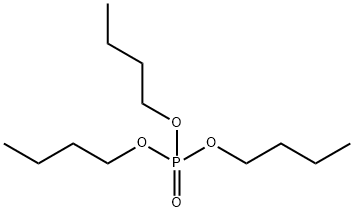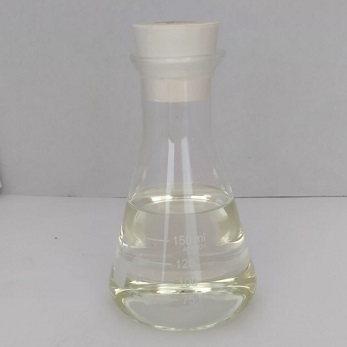General Description
Odorless colorless to yellow liquid. Toxic by ingestion and inhalation.
Reactivity Profile
TRIBUTYL PHOSPHATE(126-73-8) is incompatible with strong oxidizing agents and strong bases. Attacks some forms of plastics and rubber .
Air & Water Reactions
Water insoluble. Reacts slowly with water under basic conditions.
Health Hazard
May cause stimulation of the central nervous system.
Fire Hazard
Special Hazards of Combustion Products: Toxic fumes of PO x
Physical properties
Clear, colorless to pale yellow, odorless, slightly flammable, oily liquid
Definition
ChEBI: A trialkyl phosphate that is the tributyl ester of phosphoric acid.
Production Methods
Prepared by the reaction of phosphorus oxychloride with butyl alcohol.
Industrial uses
1. As an antifoaming agent.
2. As a plasticizer for cellulose esters, lacquers, plastics, and vinyl resins.
3. As a complexing agent in the extraction of heavy metals, especially for the
extraction of metal ions from solutions of reactor products in nuclear fuel
reprocessing.
4. As an aircraft hydraulic fluid.
5. As a heat exchange medium and dielectric.
6. As a pigment-grinding agent.
Carcinogenicity
TBP was not genotoxic in a variety of
in vivo and in vitro assays.7 It has been suggested
that the carcinogenic effects of TBP are
species- and organ specific. The necrotic
actions of TBP (or a metabolite) on rat urinary
bladder epithelium may induce chronic repair
processes that cause the normal epithelium to
be transformed into its metaplastic and neoplastic
forms.
TBP was not teratogenic when administered
to rats and rabbits during gestation;
fetotoxic effects (delayed ossification and reduced
fetal body weights) occurred in rats at
doses that caused severe maternal toxicity.
There was no evidence of reproductive toxicity
or reproductive organ pathology in twogeneration
studies in rats fed TBP in the diet.
Environmental Fate
Biological. Indigenous microbes in Mississippi River water degraded tributyl phosphate to
carbon dioxide. After 4 wk, 90.8% of the theoretical carbon dioxide had evolved (Saeger et al.,
1979).
Chemical/Physical. Complete hydrolysis yields 1-butanol and phosphoric acid via the
intermediates dibutyl phosphate and monobutyl phosphate (Thomas and Macaskie, 1996).
Purification Methods
The main contaminants in commercial samples are organic pyrophosphates, monoand dibutyl phosphates and butanol. It is purified by washing successively with 0.2M HNO3 (three times), 0.2M NaOH (three times) and water (three times), then fractionally distilled under vacuum. [Yoshida J Inorg Nucl Chem 24 1257 1962.] It has also been purified via its uranyl nitrate addition compound, obtained by saturating the crude phosphate with uranyl nitrate. This compound is crystallised three times from n-hexane by cooling to -40o, and then decomposed by washing with Na2CO3 and water. Hexane is removed by steam distillation; the water is then evaporated under reduced pressure, and the residue is distilled under reduced pressure. [Siddall & Dukes J Am Chem Soc 81 790 1959.] Alternatively, wash it with water, then with 1% NaOH or 5% Na2CO3 for several hours, then finally with water. Dry it under reduced pressure and fractionate it carefully under vacuum. It is a stable colourless oil, sparingly soluble in H2O (1mL dissolves in 165mL of H2O), but freely miscible in organic solvents. [Kuivila & Masterton J Am Chem Soc 74 4953 1952, Cox & Westheimer J Am Chem Soc 80 5441 1958, 31P NMR: Van Wazer J Am Chem Soc 78 5715 1956, Fertig et al. J Chem Soc 1488 1957, Beilstein 1 IV 1531.]
Waste Disposal
Tributyl phosphate is dissolved in a combustible solvent and is burned in a chemical incinerator equipped with an afterburner and scrubber.

